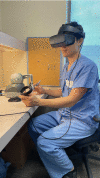The user experience design of a novel microscope within SurgiSim, a virtual reality surgical simulator
- PMID: 35933491
- PMCID: PMC9358070
- DOI: 10.1007/s11548-022-02727-8
The user experience design of a novel microscope within SurgiSim, a virtual reality surgical simulator
Abstract
Purpose: Virtual reality (VR) simulation has the potential to advance surgical education, procedural planning, and intraoperative guidance. "SurgiSim" is a VR platform developed for the rehearsal of complex procedures using patient-specific anatomy, high-fidelity stereoscopic graphics, and haptic feedback. SurgiSim is the first VR simulator to include a virtual operating room microscope. We describe the process of designing and refining the VR microscope user experience (UX) and user interaction (UI) to optimize surgical rehearsal and education.
Methods: Human-centered VR design principles were applied in the design of the SurgiSim microscope to optimize the user's sense of presence. Throughout the UX's development, the team of developers met regularly with surgeons to gather end-user feedback. Supplemental testing was performed on four participants.
Results: Through observation and participant feedback, we made iterative design upgrades to the SurgiSim platform. We identified the following key characteristics of the VR microscope UI: overall appearance, hand controller interface, and microscope movement.
Conclusion: Our design process identified challenges arising from the disparity between VR and physical environments that pertain to microscope education and deployment. These roadblocks were addressed using creative solutions. Future studies will investigate the efficacy of VR surgical microscope training on real-world microscope skills as assessed by validated performance metrics.
Keywords: Medical education; Microscope; Microsurgery; Surgery; Surgical simulation; Virtual reality.
© 2022. CARS.
Conflict of interest statement
The authors have no relevant financial or non-financial interests to disclose.
Figures





Similar articles
-
Virtual and Augmented Reality Simulators Show Intraoperative, Surgical Training, and Athletic Training Applications: A Scoping Review.Arthroscopy. 2025 Feb;41(2):505-515. doi: 10.1016/j.arthro.2024.02.011. Epub 2024 Feb 21. Arthroscopy. 2025. PMID: 38387769
-
A Comparison of Robotic Simulation Performance on Basic Virtual Reality Skills: Simulator Subjective Versus Objective Assessment Tools.J Minim Invasive Gynecol. 2017 Nov-Dec;24(7):1184-1189. doi: 10.1016/j.jmig.2017.07.019. Epub 2017 Jul 27. J Minim Invasive Gynecol. 2017. PMID: 28757439 Clinical Trial.
-
Effect of Immersive Virtual Reality Teamwork Training on Safety Behaviors During Surgical Cases: Nonrandomized Intervention Versus Controlled Pilot Study.JMIR Med Educ. 2025 May 1;11:e66186. doi: 10.2196/66186. JMIR Med Educ. 2025. PMID: 40311122 Free PMC article.
-
Highly immersive virtual reality laparoscopy simulation: development and future aspects.Int J Comput Assist Radiol Surg. 2018 Feb;13(2):281-290. doi: 10.1007/s11548-017-1686-2. Epub 2017 Nov 18. Int J Comput Assist Radiol Surg. 2018. PMID: 29151194
-
Virtual reality simulation training for health professions trainees in gastrointestinal endoscopy.Cochrane Database Syst Rev. 2018 Aug 17;8(8):CD008237. doi: 10.1002/14651858.CD008237.pub3. Cochrane Database Syst Rev. 2018. PMID: 30117156 Free PMC article.
Cited by
-
A Survey on the Design of Virtual Reality Interaction Interfaces.Sensors (Basel). 2024 Sep 25;24(19):6204. doi: 10.3390/s24196204. Sensors (Basel). 2024. PMID: 39409244 Free PMC article. Review.
-
Characterizing the untapped potential of virtual reality in plastic and reconstructive surgical training: A systematic review on skill transferability.JPRAS Open. 2024 Jul 6;41:295-310. doi: 10.1016/j.jpra.2024.06.015. eCollection 2024 Sep. JPRAS Open. 2024. PMID: 39188661 Free PMC article. Review.
References
MeSH terms
LinkOut - more resources
Full Text Sources
Miscellaneous

